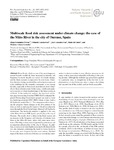Mostrar el registro sencillo del ítem
Multiscale flood risk assessment under climate change: the case of the Miño river in the city of Ourense, Spain
| dc.contributor.author | Fernández-Novoa, Diego | |
| dc.contributor.author | García-Feal, Orlando | |
| dc.contributor.author | González-Cao, José | |
| dc.contributor.author | DeCastro, Maite | |
| dc.contributor.author | Gómez-Gesteira, Moncho | |
| dc.date.accessioned | 2023-03-17T17:25:20Z | |
| dc.date.available | 2023-03-17T17:25:20Z | |
| dc.date.issued | 2022 | |
| dc.identifier.citation | Fernández-Nóvoa, D., García-Feal, O., González-Cao, J., deCastro, M., and Gómez-Gesteira, M.: Multiscale flood risk assessment under climate change: the case of the Miño River in the city of Ourense, Spain, Nat. Hazards Earth Syst. Sci., 22, 3957–3972, https://doi.org/10.5194/nhess-22-3957-2022, 2022. | es_ES |
| dc.identifier.uri | http://hdl.handle.net/2183/32715 | |
| dc.description.abstract | [Abstract:] River floods, which are one of the most dangerous natural hazards worldwide, have increased in intensity and frequency in recent decades as a result of climate change, and the future scenario is expected to be even worse. Therefore, their knowledge, predictability, and mitigation represent a key challenge for the scientific community in the coming decades, especially in those local areas that are most vulnerable to these extreme events. In this sense, a multiscale analysis is essential to obtain detailed maps of the future evolution of floods. In the multiscale analysis, the historical and future precipitation data from the CORDEX (Coordinated Regional Downscaling Experiment) project are used as input in a hydrological model (HEC-HMS) which, in turn, feeds a 2D hydraulic model (Iber+). This integration allows knowing the projected future changes in the flow pattern of the river, as well as analyzing the impact of floods in vulnerable areas through the flood hazard maps obtained with hydraulic simulations. The multiscale analysis is applied to the case of the Miño-Sil basin (NW Spain), specifically to the city of Ourense. The results show a delay in the flood season and an increase in the frequency and intensity of extreme river flows in the Miño-Sil basin, which will cause more situations of flooding in many areas frequented by pedestrians and in important infrastructure of the city of Ourense. In addition, an increase in water depths associated with future floods was also detected, confirming the trend for future floods to be not only more frequent but also more intense. Detailed maps of the future evolution of floods also provide key information to decision-makers to take effective measures in advance in those areas most vulnerable to flooding in the coming decades. Although the methodology presented is applied to a particular area, its strength lies in the fact that its implementation in other basins and cities is simple, also taking into account that all the models used are freely accessible. | es_ES |
| dc.description.sponsorship | Xunta de Galicia; ED431C 2021/44 | es_ES |
| dc.description.sponsorship | FEDER; 0034_RISC_ML_6_E | es_ES |
| dc.description.sponsorship | Xunta de Galicia; ED481B-2021-108 | es_ES |
| dc.language.iso | eng | es_ES |
| dc.publisher | European Geosciences Union | es_ES |
| dc.relation.uri | https://doi.org/10.5194/nhess-22-3957-2022 | es_ES |
| dc.rights | Atribución 3.0 España | es_ES |
| dc.rights.uri | http://creativecommons.org/licenses/by/3.0/es/ | * |
| dc.subject | Precipitation data | es_ES |
| dc.subject | CORDEX project | es_ES |
| dc.subject | Coordinated Regional Downscaling Experiment | es_ES |
| dc.subject | Hydrological models | es_ES |
| dc.subject | HEC-HMS | es_ES |
| dc.subject | Hydraulic models | es_ES |
| dc.subject | Iber+ | es_ES |
| dc.subject | Miño-Sil basin | es_ES |
| dc.subject | Floods | es_ES |
| dc.title | Multiscale flood risk assessment under climate change: the case of the Miño river in the city of Ourense, Spain | es_ES |
| dc.type | info:eu-repo/semantics/article | es_ES |
| dc.rights.access | info:eu-repo/semantics/openAccess | es_ES |
| UDC.journalTitle | Natural Hazards and Earth System Sciences | es_ES |
| UDC.volume | 22 | es_ES |
| UDC.issue | 12 | es_ES |
| UDC.startPage | 3957 | es_ES |
| UDC.endPage | 3972 | es_ES |
| dc.identifier.doi | 10.5194/nhess-22-3957-2022 |






